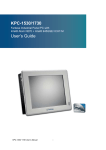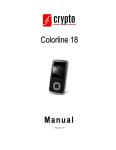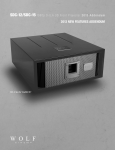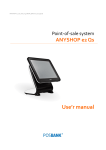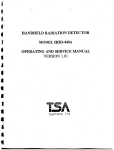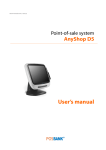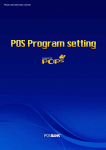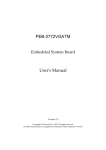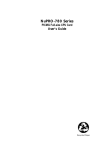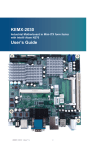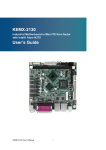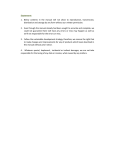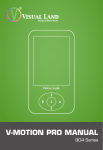Download User's manual
Transcript
PBUM-BLUO D25(Rev001;140221) Point-of-sale system POS2100 User’s manual -Table of ContentsUSER’S MANUAL REVISION HISTORY ............................................................................................................................... 4 PREFACE ......................................................................................................................................................................................... 5 SYMBOL; MARK .............................................................................................................................................................................. 6 COPYRIGHT..................................................................................................................................................................................... 7 WARRANTY ..................................................................................................................................................................................... 8 SAFETY INSTRUCTIONS.................................................................................................................................................................. 9 NOTICE.......................................................................................................................................................................................... 10 LIABILITY LIMITATION ...................................................................................................................................................................11 INSTALLATION RECOMMENDATIONS .......................................................................................................................................... 12 1.PRODUCTOVERVIEW ....................................................................................................................................................... 13 (1) INSIDE YOUR PACKAGE ............................................................................................................................................................................... 13 (2) PRE-INSTALLATION PREPARATION ............................................................................................................................................................ 14 (3) PRODUCT OUTLINE .....................................................................................................................................................................................15 (4) CONFIGURATION ....................................................................................................................................................................................... 16 (5) I/O PORT: DETAILS ...................................................................................................................................................................................... 18 (6) SETTING UP: KEYBOARD & MOUSE CONNECTION .................................................................................................................................... 20 (7) SETTING UP: CONNECTION USB PORT ....................................................................................................................................................... 21 (8) SETTING UP: CONNECTION VIA ETHERNET PORT (LAN) ............................................................................................................................ 22 (9) SETTING UP: LINE-OUT, MIC-IN, LINE-IN CONNECTION ..............................................................................................................................23 (10) SETTING UP: PRINTER CONNECTION ....................................................................................................................................................... 24 (11) SETTING UP: POWER CABLE CONNECTION .............................................................................................................................................. 25 (12) SWITCHING ON POS ................................................................................................................................................................................. 26 (13) SHUTTING DOWN POS ..............................................................................................................................................................................27 (14) SYSTEM DRIVERS ..................................................................................................................................................................................... 28 2. BLUOD25MODULE REPLACEMENT .................................................................................................................................. 29 (1) SEPARATING LCD MODULE ........................................................................................................................................................................ 29 (2) SEPARATING SSD MODULE ......................................................................................................................................................................... 31 (3) SEPARATING MOTHER BOARD & USB PCB MODULE ...................................................................................................................................35 (4) SEPARATING ADAPTER MODULE ............................................................................................................................................................... 39 (5) SEPARATING STAND BACK ......................................................................................................................................................................... 41 3.INSTALLATION OF OPTION DEVICE ................................................................................................................................... 43 (1) INSTALLATION CDP MODULE..................................................................................................................................................................... 43 (2) INSTALLATION 2ND DISPLAY MODULE ....................................................................................................................................................... 45 (3) INSTALLATION MSR MODULE .................................................................................................................................................................... 47 (4) INSTALLATION SPEAKER MODULE ............................................................................................................................................................ 50 (5) INSTALLATION LPT MODULE ..................................................................................................................................................................... 54 (6) INSTALLATION USB PCB MODULE ..............................................................................................................................................................57 (7) INSTALLATION RAM MODULE.................................................................................................................................................................... 62 (8) INSTALLATION 2ND STORAGE(SSD) MODULE ............................................................................................................................................. 66 4.MOTHERBOARD............................................................................................................................................................. 71 (1) MOTHERBOARD OVERVIEW ........................................................................................................................................................................72 (2) MOTHERBOARD LAYOUT............................................................................................................................................................................ 73 (3) EXT TERM BOARD....................................................................................................................................................................................... 76 (4) POWER SWITCH BOARD............................................................................................................................................................................. 78 (5) DRAWER KICKER BOARD ............................................................................................................................................................................ 79 (6) JUMPERS .................................................................................................................................................................................................... 80 5.BIOSSETUPUTILITY.......................................................................................................................................................... 84 (1) MANAGING AND UPDATING YOUR BIOS .................................................................................................................................................... 84 (2) BIOS SETUP PROGRAM ...............................................................................................................................................................................87 (3) MAIN SETUP ................................................................................................................................................................................................87 6.TROUBLESHOOTING...................................................................................................................................................... 110 (1) NETWORK ISSUES ..................................................................................................................................................................................... 110 (2) MSR ISSUES............................................................................................................................................................................................... 110 (3) USB ISSUES ............................................................................................................................................................................................... 110 (4) LCD ISSUES ............................................................................................................................................................................................... 110 (5) TOUCH-SCREEN ISSUES ............................................................................................................................................................................ 111 (6) POWER ISSUES ......................................................................................................................................................................................... 111 (7) PS/2 KEYBOARD ISSUES ............................................................................................................................................................................ 111 (8) BOOTING ISSUES ...................................................................................................................................................................................... 111 SPECIFICATION........................................................................................................................................................... 113 2 Copyright© Specifications and information contained in this manual are furnished for informational use only, and are subject to change at any time without notice. The information contained in this document is subject to change without notice. We make no warranty of any kind with regard to this material, including, but not limited to, the implied warranties of merchantability and fitness for a particular purpose. We shall not be liable for errors contained herein or for incidental or consequential damages in connection with the furnishing, performance, or use of this material. This document contains proprietary information that is protected by copyright. All rights are reserved. No part of this document may be photocopied, reproduced or translated to another language without the prior written consent of the manufacturer. 3 User’s manual Revision History Changes to the POS2100 D25 User’s manual are listed below. Rev No. Revision History Date /author PBUM-BLUO (Rev001;140221) D25 2014.02.21 4 Preface This User's Guide gives information about main unit/IO port layout, basic setup, component installation, and board layout for point of sale system "POS2100 D25" Intended Audience The User's Guide is intended for technically qualified personnel. It is not intended for general audiences. Document Organization The chapters in this Product User’s manual are arranged as follows: 1. 2. 3. 4. 5. 6. product package contents system configuration Harness (cable connector) BIOS Setup Installing and Replacing POS SYSTEM Components: instructions on how to install the motherboard and other POS hardware components. Product specification 5 SYMBOL; MARK CE MARK 6 This device complies with the requirements of the EEC directive 2004/108/EC with regard to “Electromagnetic compatibility” and 2006/95/EC “Low Voltage Directive”. FCC This device complies with part 15 of the FCC rules. Operation is subject to the following two conditions: (1) This device may not cause harmful interference. (2) This device must accept any interference received, including interference that may cause undesired operation. KC Korea Certification mark. Certificate No. - WEEE Recycling and disposal of electric and electronic devices and their components This product should not be mixed with other commercial wastes for disposal. Copyright This publication, including all photographs, illustrations and software, is protected under international copyright law with all rights reserved to the manufacturer. Neither this manual, nor any of the material contained herein, may be reproduced without express written consent of the author. POS2100 D25 * Other names and brands may be claimed as the property of others. Copyright© 7 Warranty We guarantee our POS terminal product and its parts against defects in materials and workmanship, under proper use, for a standard period of 2 years from the original date of purchase. During this period, we will repair or replace defective and/or faulty products or parts without charge to the customer for parts and labor. The 1st year includes servicing and new or refurbished replacement parts free of charge, with one-way shipping costs borne by the seller. The customer shall, however, be responsible for the return delivery costs. The 2nd year also includes free of charge servicing and parts, but a limited warranty requires the entire shipping cost to be borne by the customer. Products out of the warranty period or scope shall be diagnosed at the customer's expense. In the case of product damage due to error on part of the consumer, incorrect usage, carelessness or natural phenomenon, the customer shall bear the full cost for both repair and delivery. 8 Safety Instructions 1. To disconnect the machine from the electrical power supply, turn off the power switch and remove the power cord plug from the wall socket. 2. The wall socket must be easily accessible and in close proximity to the machine. 3. Read these instructions carefully. Save these instructions for future reference. 4. Follow all warnings and instructions marked on the product. 5. Do not use this product near water. 6. Do not place this product on an unstable cart, stand, or table. The product may fall, causing serious damage to the product. 7. Slots and openings in the cabinet and the back or bottom are provided for ventilation to ensure reliable operation of the product and to protect it from overheating. These openings must not be blocked or covered. 8. The openings should never be blocked by placing the product on a bed, sofa, rug, or other similar surface. 9. This product should never be placed near or over a radiator or heat register or in a built-in installation unless proper ventilation is provided. 10. Never push objects of any kind into this product through cabinet slots as they may touch dangerous voltage points or short out parts that could result in a fire or electric shock. Never spill liquid of any kind on the product. 9 Notice 1. 2. 3. 4. 5. 6. 7. 8. 9. Always ensure that the correct power voltage is used as a precaution against fire and electrical shock. Avoid exposing product to direct sunlight. Do not use product in areas of high humidity. Doing so may cause low reliability and/or operational malfunction. Be careful of static electricity on PCB of system with anti-static appliances. Doing so may cause inferior reliability and shorted product life. Keep product away from highly static areas. This may lead to inferior performance and reduced life cycle. Do not interfere with, or obstruct metal components inside product. Doing so may cause the risk of fire or electric shock. Do not pull on power cable or peripheral devices’ connector cable. Doing so may cause fire, electric shock or electronic system malfunction. Use caution when around other electronic devices with possible high frequency or electro-magnetic effects e.g. Audio, Electronic-range etc. Doing so will lead to the serious risk of product malfunctioning or a system error occurring. Ensure that batteries are replaced correctly. Failure to do this may result in sudden explosions. Dispose of used batteries properly according to the instructions. 10 Liability Limitation ● Installation and maintenance We recommend that you inquire about product installation, maintenance and repair service from the official service center and agent office. AXON takes no responsibility for malfunctions or system errors occurring after service and/or system check carried out by unofficial service providers. ● High frequency appliances This product is qualified by FCC, CE and KC compliances, and is thus governed by these qualifications’ safety regulations. However, the product can affect and be affected by other high frequencies generated around it. As such, AXON does not consider liability for any system error or disorder due to this issue. ● Electronic noise emitting equipment We recommend using the product away from electronic noise emitting equipment such as heaters, motors, fluorescent lights, TVs etc. as it may cause interruption or interference with normal operation. ● Installation location For optimal performance, the product should be kept in an environment of lower than 65% humidity and in a temperature of 10 ~ 30℃. Please also keep away from direct sun-light. ● Cleaning procedure Cleaning with chemical based products (in particular those containing benzyl or chemical thinning agents) can damage the exterior surfaces of the product. We recommend using a soft damp cloth and wiping gently, taking particular care when dealing with the LCD display screen. ● Product limitations 1. The use of this product for anything other than POS tasks is strictly prohibited. The product is not supported for regular PC and interface operation. 2. This product is for business use only, and not for usage in the home. 3. Both hardware and software are both fully configured. 4. Normal operating is guaranteed on a steady power connection. 11 Installation Recommendations 1. 2. 3. 4. 5. 6. 7. Avoid installing during thunderstorms. (Possibility of dangerous exposure to electricity.) Install away from damp spaces or water-leaks. Beware of static occurrence during installation. Use only ground connected and quality certified power cords and cables. Keep out of direct sun-light, extremely high or low temperatures, or high humidity areas. Install product away from areas prone to shocks or vibration. Install product away from sewing machines, welding equipment, electric stoves, audio equipment and other high frequency generating equipment. 8. Installation and use in close proximity to an air-conditioning unit is not recommended. 9. Do not connect cables underneath carpets or floorboards. 10. Only use power cables supplied by pre-approved and certified venders. 11. Never use power cords from high power source appliances. e.g. Electronic heaters, Electric stoves, Audio equipment, Air-conditioners, Refrigerators etc. 12. The use of multiple connections in a shared power outlet/socket is not recommended. 12 1. Product Overview (1) Inside Your Package 1. 2. Please check your package and confirm its contents. The POS terminal main unit, power cable, user manual and driver CD are included in the package. If any items are missing or damaged, please contact your dealer for assistance. » All user manuals and drivers are available for download on our website: www.easyset.org Adapter / Power cord Installation guide Drivers CD 13 Optional Devices: 2nd LCD monitor 12.1” 14 Optional Devices: 2nd LCD monitor 10.4” Optional Devices: 2nd LCD monitor 10.1” Optional Devices: CDP (Customer display) Optional Devices: CDP (Customer display) 15 (2) Pre-installation Preparation 1. 2. Remove protective film from touch-screen to prevent possible operating difficulties. Attach all optional parts before setting up the main POS unit. (3) Product Outline • • Each part of product may differ depending on the specific POS model. Model-specific data sheets are provided on our website at www.easyset.org (4) Configuration Refer to following diagram to identify the components on this side of the system. Front view 16 5 5 1 1 6 6 7 2 2 3 3 4 4 8 1. 2. 3. 4. 5. 6. 7. 8. LCD & Touch panel display LAN LED Storage(Default: SSD) LED Power LED Magnetic stripe reader(MSR); Option Smart card reader(SCR); Option Dallas I-button reader; Option Power switch Side view 1 2 3 4 2 1. 2. 3. 4. I/O port cover Storage (Default: SSD) Customer display; Option Dual speaker 17 (5) I/O port: Details * I/O ports may differ according to product model or options. I/O view 18 1 I/O view 1. Raise the I/O COVER. Standard I/O port 19 (6) Setting up: Keyboard & Mouse Connection Connecting the keyboard and mouse to the PS/2 port on the bottom panel. or connecting the USB type keyboard and mouse to the USB port on the bottom panel. 20 (7) Setting up: Connection USB Port USB ports are provided in the POS unit, two at the rear I/O and four at the side, all of which support the standard USB 2.0. Some USB devices (optional devices) are only functional with specific driver software installed. If multiple USB devices are used together, this may result in abnormal functionality. Using a USB hub with external adapter for supplying power is recommended. Dependent on the type of device, it is possible for the USB device to be recognized later than normal. USB port (6port support) 21 (8) Setting up: Connection via Ethernet Port (LAN) The Ethernet port located at the rear I/O supports 10/100/1000Mbps using an RJ45 connector cable. When connected properly, the LAN LED light will be switched on. Through a network hub. Refer to the table below for the LAN port LED indications. 22 LINK/ACT LED SPEED LED LINK / ACT LED SPEED LED Status OFF YELLOW BLINKING Status OFF ORANGE GREEN Description No link Linked Data activity Description 10Mbps connection 100Mbps connection 1Gbps connection (9) Setting up: Line-out, Mic-in, Line-in connection • • • Line In port (light blue): This port connects a tape, CD, DVD player, Sources. Line Out port (lime): This port connects a headphone or a speaker.In4-channel, 6-channel and 8-channel configuration, the function of this port becomes Front Speaker Out. Microphone port (pink): This port connects a microphone. 23 (10) Setting up: Printer Connection Connect printer cable to either Serial &USB port as required. 24 (11) Setting up: Power Cable Connection The ‘POS 21000 D25’ POS system is equipped with a 12V/ 5A power adaptor. Connect the cable to the DC-IN port on system IO panel. 25 CAUTION : Do not pull on the adaptor cable! Disconnect cable with pulling the plug cap. (12) Switching On POS 1. 2. Press POWER button on the POS unit. (POWER LED will light up.) The power switch is located right hand side of the main body under the display unit. Confirm that Windows loads correctly. 26 (13) Shutting Down POS * For product stability, we recommend closing Windows from the O/S. Please make sure that you have closed all applications before closing Windows. 1. 2. Click ‘Start’ and select ‘Turn off Computer’ Click ‘Shut Down’ to close Windows. 27 (ex: POSReady2009 or Windows XP) 2 1 (14) System Drivers Please visit our website: www.posbank.com for the latest driver updates. Supported devices: Cash drawer, CDP (Customer Display Panel), MSR (Magnetic Swipe Reader) and printer. Driver installation ● Installation method : Driver will automatically install by clicking SETUP.EXE in your driver CD. If you require any help with installing or using our OPOS system, please contact our customer service center. ● Folder of contents of POS terminal installation driver: 1. CHIP SET DRV installation 2. VIDEO (VGA) DRV installation 3. TOUCH DRV installation 4. AUDIO DRV installation method 5. LAN DRV installations 6. AMT & ME Driver installation 7. User’s Manual, Installation guide 28 2. BLUO D25 Module Replacement (1) Separating LCD module * Warning: Completely remove power cable when opening main unit or installing optional devices. LCD Monitor module 29 Step 1. Lift up the Hinge Holder. LCD monitor module 30 Step 2. Remove the AD Cable. Step 3. Lift up the LCD module and detach from the Stand. Caution Power must be disconnected before replacing SSD. Before replace the device, remove static electricity of technician. (2) Separating SSD module * Warning: Completely remove power cable when opening main unit or installing optional devices. SSD Module 31 Step 1. Lift up the I/O Cover. SSD Module 32 [ ZOOM IN ] Step2. See printed image for details. SSD Module 33 Step3. Pull out SSD Tray by pressing the Grip. Step4. Lift up the SSD Tray. SSD Module 34 Step5. Open four Tray hinges carefully in opposite directions as in image. Step6. SSD will be separated smoothly. Push Step7. Assemble SSD bottom to join Tray bottom. Caution Power must be disconnected before replacing SSD. Before replace the device, remove static electricity of technician. (3) Separating Mother board & SUB PCB module * Warning: Completely remove power cable when opening main unit or installing optional devices. Mother board Module & SUB PCB 35 Step 1. Remove the AD Cable. Step 2. Lift up the Hinge Holder. Mother board Module & SUB PCB 36 Step 3. Lift up the LCD module and detach from the Stand. Step4. Remove the Rear cover. Mother board Module & SUB PCB 37 Step 5. Turn two hand screws and remove Main bracket. SUB PCB Step6. Turn screws and replace Mother board. Step7. Turn screws and replace SUB PCB. Mother board Mother board Module & SUB PCB 38 Step8. Reassemble a unit using the Reverse procedure of step 1-5 above. (4) Separating Adapter module * Warning: Completely remove power cable when opening main unit or installing optional devices. Adapter module 39 Step 1. Lift up the I/O Cover. Adapter module 40 Step 2. Pull out the Stand back from the Stand module and remove. Push Step 3. Turn hand screws and remove Adapter bracket. Step 4. Replace the Adapter. Adapter Adapter bracket (5) Separating Stand back * Warning: Completely remove power cable when opening main unit or installing optional devices. Stand back 41 Step1. Press upper side of Stand as in image Step2. Pull up the hook on bottom of the back side of stand Stand back 42 Step 3. Disassemble Stand back by pulling down to outward. CAUTION : Remove AC cable before disassembling Stand back. 3. Installation of option device (1) Installation CDP module * Warning: Completely remove power cable when opening main unit or installing optional devices. CDP - Option 43 Step 1. Stand Back is now removed. Step 2. Assemble the 2 display with the Hinge of the body. nd Push Step 3. Fasten 3 screws to fix the 2 display. nd CDP - Option 44 Step 4 . Remove the Io Cover and Put holes in the sample place. (RJ11, VGA Port) Step 5. Assemble the Stand back and I/O cover. (2) Installation 2nd Display module * Warning: Completely remove power cable when opening main unit or installing optional devices. 2nd display : 10.1inch, 10.4inch, 12.1inch Display - Option 45 Step 1. Stand Back is now removed. Push Step 2. Assemble the 2 display with the Hinge of the body. nd Step 3. Fasten 3 screw to fix the 2 display. nd 2nd display : 10.1inch, 10.4inch, 12.1inch Display - Option 46 Step 4 . Remove the Io Cover and Put holes in the sample place. ( RJ11, VGA Port) Step 5. Assemble the Stand back and I/O cover. (3) Installation MSR module * Warning: Completely remove power cable when opening main unit or installing optional devices. MSR - Option 47 Step 1. Lift up the I/O Cover. Step2. Assemble 2 hand screw from Side using hand. (as show above) MSR - Option 48 Step4. Assemble the MSR. Step5. I/O part put holes in the sample place. (RJ11 PORT) MSR - Option Step 6. Access to POSBANK homepage Step 7. Click on the monitor button on the toolbar Step 8. Download the MSR mapper file. Step 9. Double click lpu230.exe file. Step 10. Click NEXT.. Step 11.. After the installation is complete 'Select Device' to Make sure that the choice is normally a FW update. 49 (4) Installation Speakers module * Warning: Completely remove power cable when opening main unit or installing optional devices. Speaker - Option 50 Step 1. Remove the AD Cable Step 2. Lift up the Hinge Holder Step 3. Lift up the LCD module and detach from the Stand. Speaker - Option 51 Step 4. Remove the Rear cover. Step 5. Turn two hand screws and remove Main bracket. Speaker - Option 52 Step 6. Connect each Speaker to extend Speaker cable. Step7. Assemble the Main bracket. Step8. Assemble 2 Speakers to inner Side of body by screw. Step9. Connect each Speaker to Speaker cable. Speaker - Option 53 Step10. Reassemble a unit using the Reverse procedure of stpe1-5 above. (5) Installation LPT module * Warning: Completely remove power cable when opening main unit or installing optional devices. LPT - Option 54 Step 1. Remove the AD Cable Step 2. Lift up the Hinge Holder Step 3. Lift up the LCD module and detach from the Stand. LPT - Option 55 Step 4. Remove the Rear cover. Step 5. Turn two hand screws and remove Main bracket. LPT - Option Step6. Remove the LPT dummy from I/O bracket. Step7. Assemble the LPT with the I/O bracket. Step8. Reassemble a unit using the Reverse procedure of stpe1-5 above. 56 (6) Installation USB PCB module * Warning: Completely remove power cable when opening main unit or installing optional devices. USB PCB - Option 57 Step 1. Remove the AD Cable Step 2. Lift up the Hinge Holder Step 3. Lift up the LCD module and detach from the Stand. USB PCB - Option 58 Step 4. Remove the Rear cover. Step 5. Turn two hand screws and remove Main bracket. USB PCB - Option 59 Step 6. Use cutter and ripper to remove USB dummy. [ZOOM IN] USB PCB - Option 60 Step 7. Mother board put holes in the Sample place (as show above) Step 8. Connect cable to mother board USB5/6. Step9. Assemble the Main bracket. USB PCB - Option 61 Step10. Reassemble a unit using the Reverse procedure of step 1-5 above. (7) Installation RAM module * Warning: Completely remove power cable when opening main unit or installing optional devices. RAM - option 62 Step 1. Remove the AD Cable Step 2. Lift up the Hinge Holder Step 3. Lift up the LCD module and detach from the Stand. RAM - option 63 Step 4. Remove the Rear cover. Step 5. Turn two hand screws and remove Main bracket. RAM - option 64 Step 6. Place Mother board as in image. Stet 7. Install the Memory. RAM - option 65 Step 8. Assemble the SODIMM from the Retaining clip socket. DDR SODIMM notch (8) Installation 2nd storage (SSD) module * Warning: Completely remove power cable when opening main unit or installing optional devices. 2nd storage (SSD) 66 Step 1. Remove the AD Cable Step 2. Lift up the Hinge Holder Step 3. Lift up the LCD module and detach from the Stand. 2nd storage (SSD) 67 Step 4. Remove the Rear cover. Step 5. Turn two hand screws and remove Main bracket. 2nd storage (SSD) 68 Step6. Assemble 4 screw from HDD bracket. (as show above) [ZOOM IN 1-2] 2nd storage (SSD) 69 ZOOM-1 Step7.Turn two screws and Assemble SSD bracket. ZOOM-2 Step9. Connect each Data cable and Power cable 2nd storage (SSD) 70 Step10. Reassemble a unit using the Reverse procedure of step 1-5 above. 4. Motherboard (1) Motherboard Overview This includes description of the jumpers and connectors on the motherboard. Warring Take note of the following precautions before you install motherboard components or change any motherboard settings. 1. Unplug the power cord from the wall socket before touching any component. 2. Before handling components, use a grounded wrist strap or touch a safely grounded object or a metal object, such as the power supply case, to avoid damaging them due to static electricity. 3. Hold components by the edges to avoid touching the ICs on them. 4. Whenever you uninstall any component, place it on a grounded antistatic pad or in the bag that came with the component. 5. Before you install or remove any component, ensure that the ATX power 6. Supply is switched off or the power cord is detached from the power supply. Failure to do so may cause 71 (2) Motherboard Layout This includes description of the jumpers and connectors on the motherboard. Motherboard view 72 NO Description 1. 2. 3. 4. 5. 6. 7. 8. 9. 10. 11. 12. 13. 14. 15. 16. 17. External USB USB9 SYS FAN Power switch Reset switch nd 12V/5V Select for 2 LVDS nd 2 LVDS + COM4 Monitor Main Cable Resistive 5-wire touch USB/Touch Select Mini PCI-E COM5 Parallel LVDS + Inverter Inverter / DDC Select Speaker L Speaker R NO Description 18. 19. 20. 21. 22. 23. 24. 25. 26. 27. 28. 29. Inverter nd 12V/5V Select for 2 Display nd 2 Display (VGA + COM4) COM2 12V/R1/5V COM1 12V/R1/5V PS/2 Battery CPU FAN SATA Power CN1 SATA Power CN2 SATA 2 SATA 1 73 (2-1) Motherboard Pin Assignment Power (Input) port / Adapter Input – 12V Pin Num Description 1 +12V 2 GND 3 +12V 4 GND Pin Num Description Pin Num Description 1 Transmit + 5 (Reserved) 2 Transmit - 6 Receive - 3 Receive + 7 (Reserved) 4 (Reserved) 8 (Reserved) Pin Num Description 1 VSUB(+5V) + 2 D- 3 D+ 4 GND 74 LAN port (RJ45) USB port VGA Pin Num Description Pin Num Description 1 RED 9 KEY_PWR 2 GREEN 10 GND 3 BLUE 11 ID0/RES 4 ID2/RES 12 ID1/SDA 5 GND 13 Hsync 6 RED_RTN 14 Vsync 7 GREEN_RTN 15 ID3/SCL 8 BLUE_RTN Pin Num Description Pin Num Description 1 DCD 6 DSR 2 RXD 7 RTS 3 TXD 8 CTS 4 DTR 9 0V/5V/12V 5 GND Serial port (COM1, COM2, COM3) Keyboard port Pin Num Description Pin Num Description 1 KBDAT 4 KB5V 2 NC 5 KBCLK 3 GND 6 NC 75 (3) EXT Term Board EXT Term Board 76 COM4 COM5 COM6 USB (3-1) EXT Term Board Pin Assignment COM4 (RJ11) Pin Num Description Pin Num Description 1 GND 4 VCC12V 2 RXD 5 TXD 3 NC 6 VCC5V Pin Num Description Pin Num Description 1 DCD 5 GND 2 TXD 6 DTR 3 RXD 7 CTS 4 DSR 8 RTS COM5 (RJ45) COM6 (RJ45) Pin Num Description Pin Num Description 1 DCD 5 GND 2 TXD 6 DTR 3 RXD 7 CTS 4 DSR 8 RTS Pin Num Description Pin Num Description 1 NC 5 USB-VCC 2 NC 6 USB-D- 3 NC 7 USB-D+ 4 NC 8 USB-GND USB (RJ45) 77 (4) Power Switch Board Power Switch Board Connector Description 78 A A. Power switch (5) Drawer Kicker Board Drawer Kicker Board Connector Description B 79 C A A. Drawer Port B. Serial Port C. Mini PCI-E Slot (6) Jumpers Clear CMOS (CMOS1) This jumper allows you to clear the Real Time Clock (RTC) RAM in CMOS. You can clear the CMOS memory of date, time, and system setup parameters by erasing the CMOS RTC RAM data. The onboard button cell battery powers the RAM data in CMOS, which includes system setup information such as system passwords. To erase the RTC RAM: 1. Turn OFF the computer and unplug the power cord. 2. Remove the onboard battery. 3. Move the jumper cap from pins 1-2 (default) to pins 2-3. Keep the cap on pins 2-3 for about 5~10 second, them move the cap back to pins 1-2. 4. Re-install the battery. 5. Plug the power cord and turn ON the computer. 6. Hold down the <Del> key during the boot process and enter BIOS setup to re-enter data CAUTION: Except when clearing the RTC RAM, never remove the cap on CLRTC jumper default position. Removing the cap will cause system boot failure! 1. Clear CMOS (CMOS1) 1 Clear CMOS 1 Normal (Default) 80 2.COM1, COM2, RI/+5V/+12V Select (JCOMPWR1 / JCOMPWR2) 1 81 R1 (Default) 2 1 3 4 +5V 2 1 +12V 2 3. LVDS Backlight control mode (JLVDS_P1) 1 None PWM Mode 1 PWM Mode (Default) 4. LVDS Backlight power selection(JLVDS_P3) 82 1 1 5V (Default) 3.3V 5. VGA2 power selection(CRT_SEL) 1 5V 1 12V (Default) 6. Onboard Touch function Enable/Disable selection(USB_SEL) 83 1 Disable 1 Enable (Default) 5. BIOS Setup Utility * This chapter tells how to change the system settings through the BIOS Setup menus. Detailed descriptions of the BIOS parameters are also provided. (1) BIOS setup program This motherboard supports a programmable firmware chip that you can update using the provided utility described in section “2.1 Managing and updating your BIOS.” Use the BIOS Setup program when you are installing a motherboard, reconfiguring your system, or prompted to “Run Setup”. This section explains how to configure your system using this utility. Even if you are not prompted to use the Setup program, you can change the configuration of your computer in the future. For example, you can enable the security password feature or change the power management settings. This requires you to reconfigure your system using the BIOS Setup program so that the computer can recognize these changes and record them in the CMOS RAM of the firmware hub. The firmware hub on the motherboard stores the Setup utility. When you start up the computer, the system provides you with the opportunity to run this program. Press <Del> during the Power-On-Self-Test (POST) to enter the Setup utility; otherwise, POST continues with its test routines. If you wish to enter Setup after POST, restart the system by pressing <Ctrl+Alt+Delete>, or by pressing the reset button on the system chassis. You can also restart by turning the system off and then back on. Do this last option only if the first two failed. The Setup program is designed to make it as easy to use as possible. Being a menu-driven program, it lets you scroll through the various sub-menus and make your selections from the available options using the navigation keys. • The default BIOS settings for this motherboard apply for most conditions to ensure optimum performance. If the system becomes unstable after changing any BIOS settings, load the default settings to ensure system compatibility and stability. Select the Load Default Settings item under the Exit Menu. See section “2.7 Exit Menu.” • The BIOS setup screens shown in this section are for reference purposes only, and may not exactly match what you see on your screen. 84 1.1 Legend Box The keys in the legend bar allow you to navigate through the various setup menus. Key(s) F1 Esc Function Description General help, only for Status Page Setup Menu and Option Page Setup Menu Return to the main menu from a sub-menu or prompts you to quit the setup program ←,→ Move to the item in the left or right hand ↑,↓ Move to previous or next item Enter Brings up a selection menu for the highlighted field + or PgUp Moves the cursor to the first field - or PgDn Moves the cursor to the last field F5 F6, F7 F10 Loads the previous values Loads the fail-safe / optimized defaults Saves changes and exits Setup 85 1.2 List Box This box appears only in the opening screen. The box displays an initial list of configurable items in the menu you selected. 1.3 Sub-menu Note that a right pointer symbol (▶) appears to the left of certain fields. This pointer indicates that you can display a sub-menu from this field. A sub-menu contains additional options for a field parameter. To display a sub-menu, move the highlight to the field and press <Enter>. The sub-menu appears. Use the legend keys to enter values and move from field to field within a sub-menu as you would within a menu. Use the <Esc> key to return to the main menu. Take some time to familiarize yourself with the legend keys and their corresponding functions. Practice navigating through the various menus and submenus. If you accidentally make unwanted changes to any of the fields, press <F6> to load the fail-safe default values. While moving around through the Setup program, note that explanations appear in the Item Specific Help window located to the right of each menu. This window displays the help text for the currently highlighted field. 86 (2) BIOS Setup 2.1 BIOS Menu Screen When you enter the BIOS, the following screen appears. The BIOS menu screen displays the items that allow you to make changes to the system configuration. To access the menu items, press the up/down/right/left arrow key on the keyboard until the desired item is highlighted, then press [Enter] to open the specific menu. 87 2.2 Main Setup This menu gives you an overview of the general system specifications. The BIOS automatically detects the items in this menu. Use this menu for basic system configurations, such as time, date etc. 88 1. System Language English 2. System Time The time format is <Hour>,<Minute>,<Second>. 3. System Date The date format is <Date>,<Month>,<Day>,<Year>. 2.3 Advanced BIOS Setup Select the Advanced tab from the setup screen to enter the Advanced BIOS Setup screen. You can select any of the items in the left frame of the screen, such as Chipset configuration, to go to the sub menu for that item. You can display an Advanced BIOS Setup option by highlighting it using the <Arrow> keys. All Advanced BIOS Setup options are described in this section. The Advanced BIOS Setup screen is shown below. The sub menus are described on the following pages. 89 2.4 Launch PXE 0Prom [Disable] Configuration options: [Disabled] [Enabled] 90 2.5 ACPI Settings [S3 (suspend to RAM)] 91 System ACPI parameters. Select the highest ACPI sleep state the system will enter when the SUSPEND button is pressed . Wake on LAN control [Disabled] Enable/Disable WOL function Wake on Ring control [Disabled] Enable/Disable Wake on Ring function PS2 KB/MS PME control[Disabled] PS2 keyboard/Mouse PME Control any key or click as wake up event. Resume on RTC Alarm[Disabled] Enable or disable system wake on alarm even. When enabled, system will wake upon the hr/min/sec specified. 2.6 CPU Configuration 92 Hyper-Threading[Enabled] Enabled for Windows XP and Linux (OS optimized for Hyper-Threading Technology) And Disable for other OS(OS not optimized for Hyper-Threading Technology) Execute Disable Bit [Enabled] XD can prevent certain classes of malicious buffer overflow attacks when combine with a supporting OS (Windows Server 2003 SP1,Windows XP SP2,SuSE Linux9.2, RedHat Enterprise 3 update 3.) Limit CPUID Maximum[Disable] Disable for Windows XP 2.7 IDE Configuration • IDE Devices configuration 93 SATA Controller[Enable] SATA ports(1-2)Device names if Present and Enable. Configuration SATA as [AHCI] Select a configuration for SATA controller . SATA Port 1/2 [Enable] SATA port(1-2) Enable/Disable 2.8. USB Configuration • USB configuration Parameters 94 Legacy USB support [Enable] Enables Legacy USB support AUTO option disable legacy support if no USB device are connected DISABLE option will keep USB device available only for EFI applications EHCI Hand-off[Enable] This is a workaround for OSes without EHCI hand-off support the EHCI ownership change should be claimed by EHCI driver . 2.9 Super I/O Configruation • System supper I/O CHIP parameters 95 Serial Port 1 configuration Set parameters of serial port 1 (COM1) Serial Port 2 configuration Set parameters of serial port 2 (COM2) Parallel Port configuration Set parameters of parallel port Serial Port 3 configuration Set parameters of serial port 3 (COM3) Serial Port 4 configuration Set parameters of serial port 4 (COM4) Serial Port 5 configuration Set parameters of serial port 5 (COM5) Serial Port 6 configuration Set parameters of serial port 6 (COM6) AC Power Loss state[Always OFF] Set the state after power loss. Watch Dog count Mode[Second(s) Mode] Select watch Dog count mode. Watch Dog Time-out Value Timer will start to count from end of POST .00- Time out Disable. 96 2.10 Hardware Monitor 97 Smart Fan Mode configuration Smart Fan Mode select 98 System smart fan mode [Disable] System smart Fan mode select CPU smart fan mode [Disable] System smart Fan mode select 2.11 Chipset 99 2.12 Host Bridge 100 Host bridge parameters Memory Frequency and Timing Display memory Frequency and Timing settings. 2.13 Boot Display Configuration 101 2.14 LCD Panel type [VBIOS Default] Select LCD Panel used by internal Graphics Device by Select the appropriate setup item. 102 Color depth [24Bits] Select color Depth for LVDS 103 2.15 South Bridge parameters 104 Into South Bridge Subdiredtory 105 TPT Devices Set parameters of INTEL IO controller Hub(TPT) devices PCI Express Root port 4 Set parameters of PCI Express Root port 4 settings Onboard LAN controller [Enabled] Enable or Disable onboard LAN controller 2.16 Boot 106 2.17 Security 107 Administrator password Set administrator password User password Set User password 2.18 Save & Exit 108 Save Changes and Exit Exit system setup after saving the changes. Discard changes and Exit Exit system setup without saving any changes. Save changes and Reset Reset teh system after saving the changes. Discard changes and Reset Reset system setup without saving any changes. Save changes Save chnages done so far to any of the setup options. Discard changes Discard changes done so far to any of the setup options. Restore Defaults Restore/Load Default values for all the setup options. 109 Save as User Defaults Save the changes done so far as User Defaults Restore User Defaults Restore the User Default to all teh setup options. 6. Troubleshooting (1) Network Issues 110 Symptom Corrective Procedure Cannot access LAN ▪ Check if hub or switch is working correctly ▪ Check RJ45 cable connection ▪ Check if LAN LEDs are on/off ▪ Reinstall LAN card ▪ Replace motherboard (2) MSR Issues Symptom Corrective Procedure MSR does not respond ▪ Check MSR reader cable connection ▪ Check motherboard and LCD cable connection ▪ Check MSR board cable connection (3) USB Issues Symptom Corrective Procedure USB port doesn’t work ▪ Check Windows device manager for device recognition ▪ Check USB device status and connection ▪ Erase and re-install USB driver ▪ Change USB device (4) LCD Issues Symptom Corrective Procedure LCD backlight doesn’t work ▪ Check LCD cable connection ▪ Check inverter cable connection ▪ Replace inverter cable ▪ Change LCD panel (5) Touch-screen Issues Symptom Corrective Procedure Touch-screen doesn’t detect touch operations ▪ Check touch-screen cable connection ▪ Check motherboard and LCD cable connection ▪ Check BIOS set-up (6) Power Issues Symptom Corrective Procedure System switches off abruptly and system does not load ▪ Check A/C cable connection ▪ Check motherboard power connection ▪ Check CPU settings/status ▪ Check DRAM settings ▪ Check power button cable connection ▪ Change power adaptor unit (7) PS/2 Keyboard Issues Symptom Corrective Procedure PS/2 Keyboard Issues ▪ Check card-reader cable ▪ Check CN6 jumper (8) Booting Issues Symptom Corrective Procedure Re-booting during system operation ▪ Check SATA cable connection ▪ Check memory status 111 Maintenance Safety Warning AXON will not be held responsible for repairs conducted via service providers other than those officially specified by the seller. General Guidelines 1. 2. 3. 4. 5. Always disconnect the unit from the power outlet. Disconnect all cables from the POS main unit before attempting reparation. Keep all components in the static-proof packaging provided until ready for installation. If the device still is not functioning after repair, please turn off the POS unit and contact the customer service center for a follow-up inspection. We recommend that power supply unit (PSU) checks and monitor repairs only be performed at a certified service center. 112 Specification BLUO D25 Intel Atom processor D2550 (1MB Cache, 1.86 GHz, Dual Core for Cedarview-D) Intel NM10 SATA2(3Gb/s) 2.5 inch HDD or SSD (Max. 2 Optional) Support AHCI DDR3-1066MHz SODIMM 2GB (MAX. 4GB) Integrated Intel GMA HD 3650 - CPU Chipset Storage Memory Graphic AMT Resolution Display Touch screen Viewing angle USB Serial port Internal I/O External I/O Options Display port Extension slot Primary display USB PS/2 Serial port LAN Audio Display port MSR Speaker Side USB Serial port SCR Dallas Back up battery Customer display 2nd LCD 2nd storage Cash drawer port Parallel port WiFi Operating Temperature Storage Temperature Qualification Power OS Support Dimension (W x H x D) 15" LED Backlight LCD 250 cd/㎡ (1024 x 768 resolution) True Flat Capacitive or 5-wired Resistive Touch 3 Ports (reserved for touch controller, MSR reader, mini PCIe) COM 5 (reserved for cash drawer port) & COM 6 (reserved for MSR) VGA & COM 4 (reserved for CDP) Mini PCIe 24bit LVDS Rear 4 1 Port (reserved for Keyboard & Mouse) COM 1 ~ 3 with 5V/12V power output on 9pin Realtek RTL 8111E Ethernet Controller Realtek ALC 892 / Line-out, Mic-in VGA x 1 port Comply with ISO 7811, Support 1 & 2 & 3 track 2 x 0.8W (Stereo) 4 Ports (USB 2.0) EMV level 1 Dallas I-button reader Smart battery (supports up to 1 packs) VFD type (20 x 2) Alphabet & numeric 10.1" LCD or 10.4" LCD or 12.1 LCD (1024 x 768 resolution) 2nd SSD / HDD storage 1 Port (RJ11 shared with COM5) 1 Port Mini PCIe for wireless LAN 0 ℃ ~ 40 ℃ at 10% ~ 80% humidity -20 ℃ ~ 60 ℃ at 10% ~ 80% humidity CE, FCC, KC Adaptor 12V/ 5A Windows XP/Vista, Windows 7, POS Ready 2009 415 x 305 x 385(mm), 16.3 x 12 x 15.1(inch) *Product specifications may differ according to region and may be changed without prior notice. *MSR is not supported PS/2 interface 113

















































































































